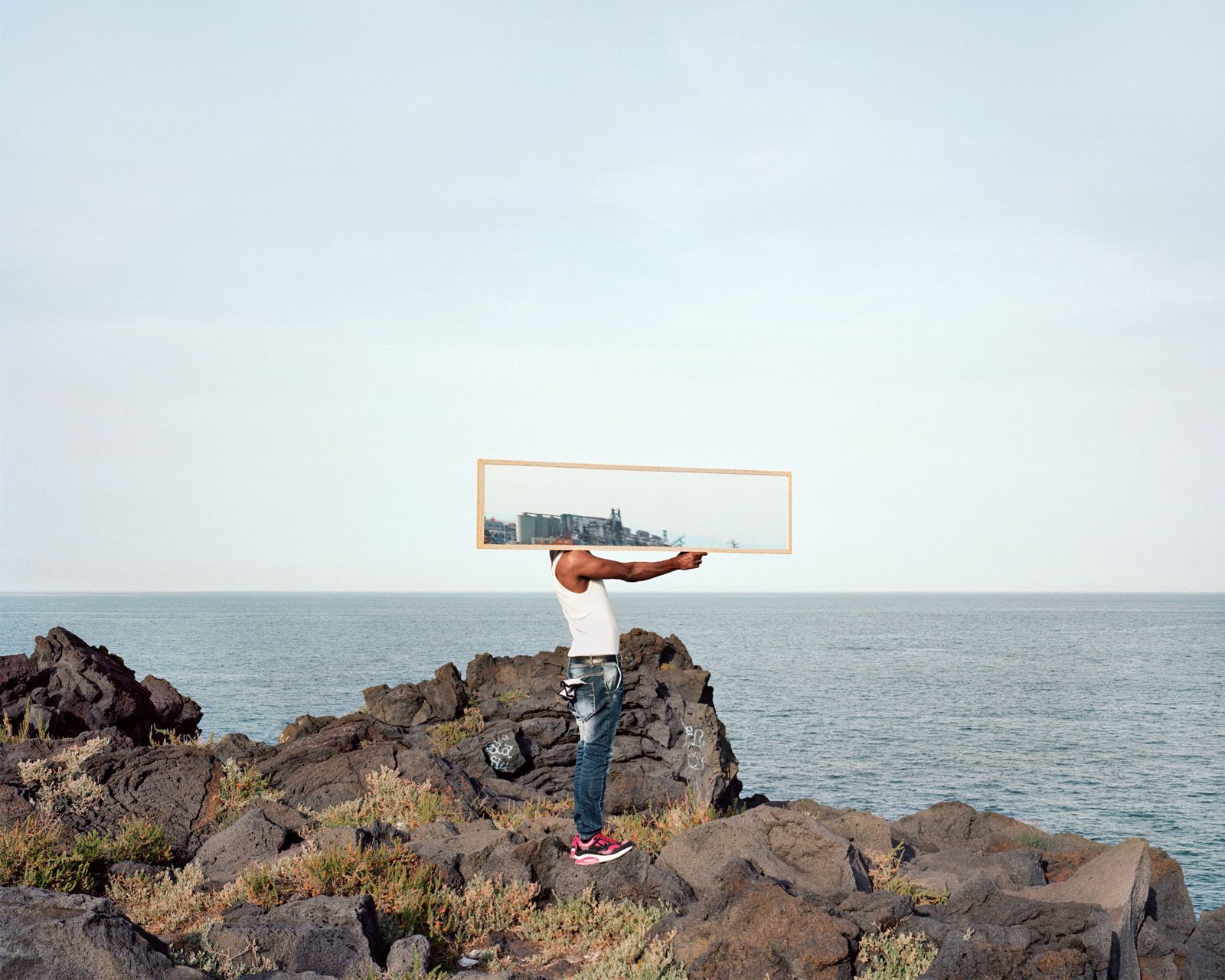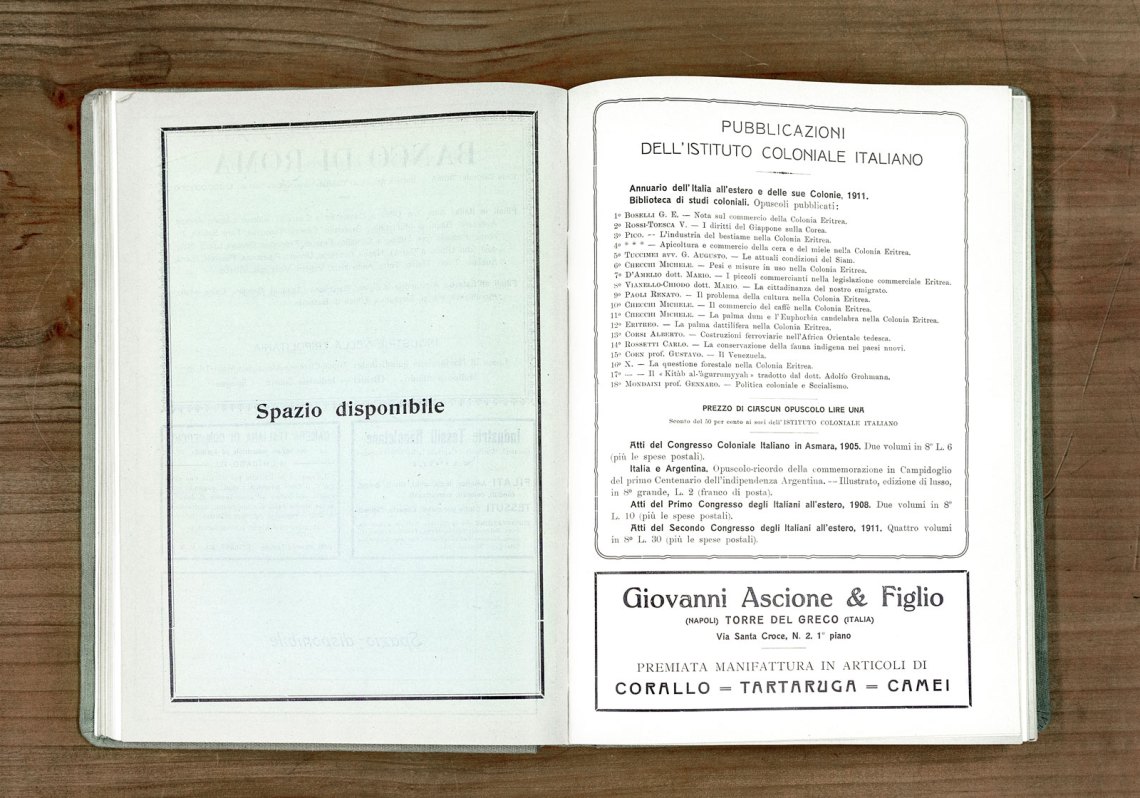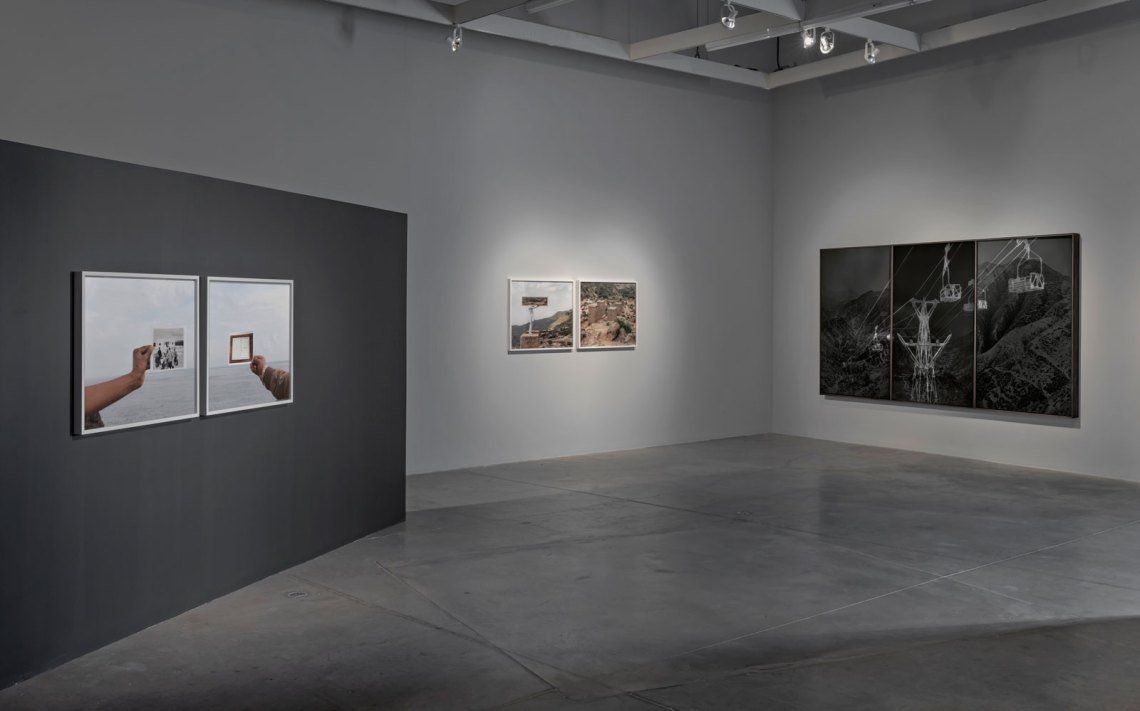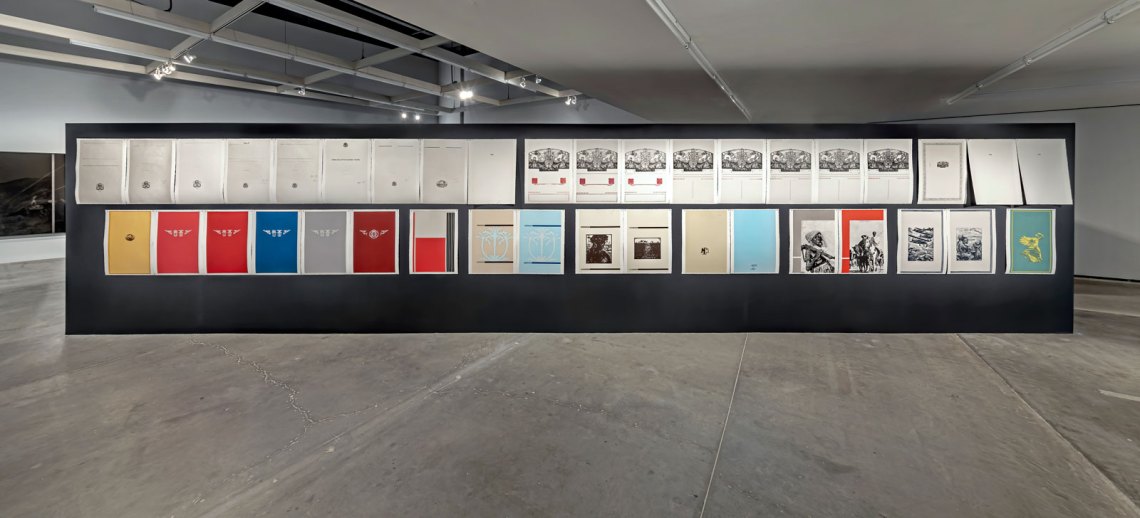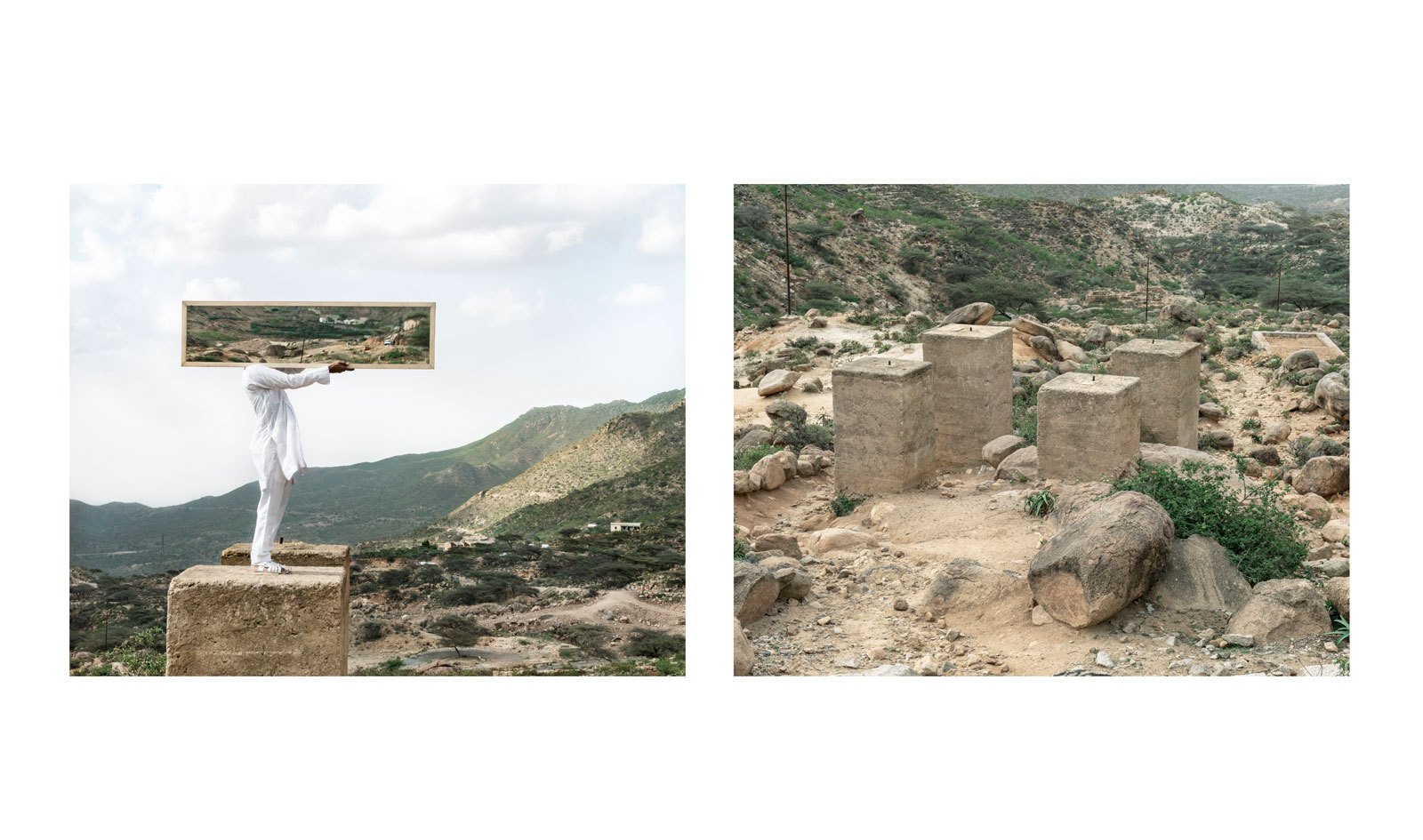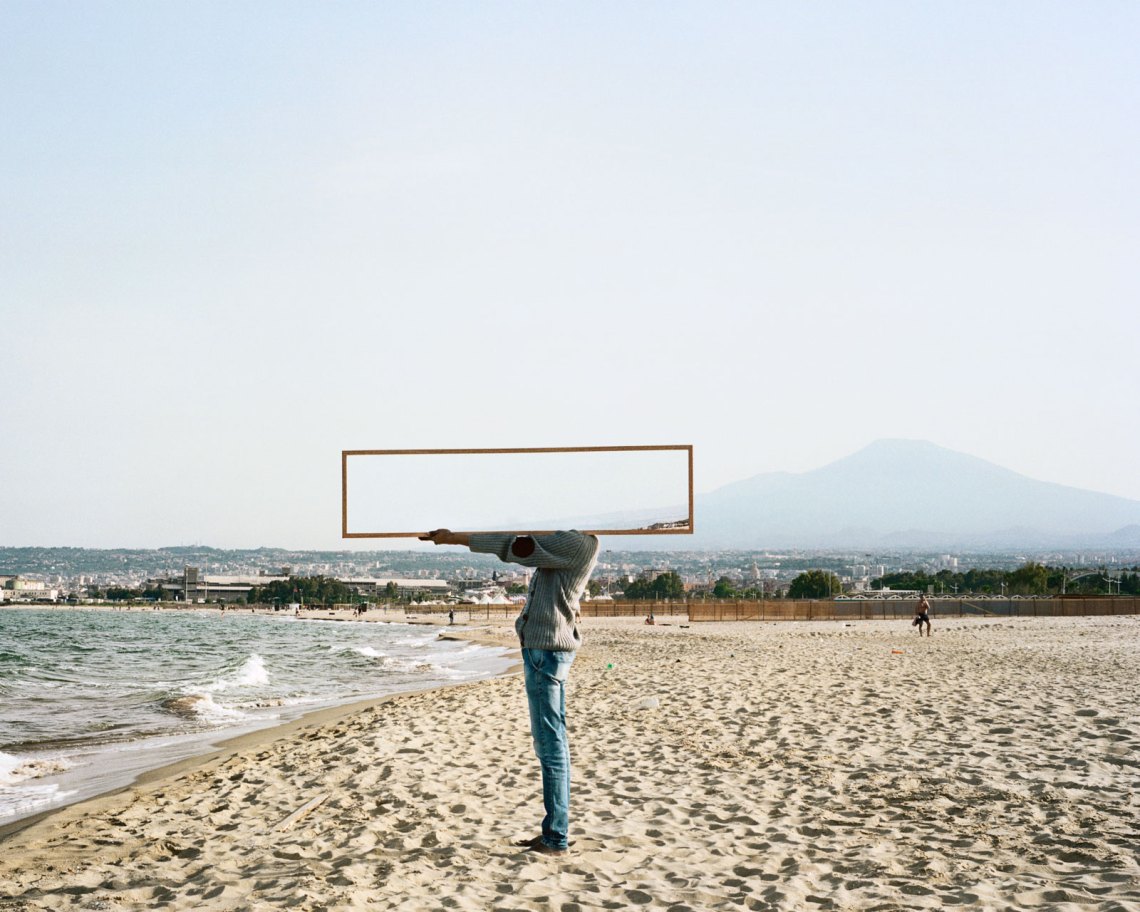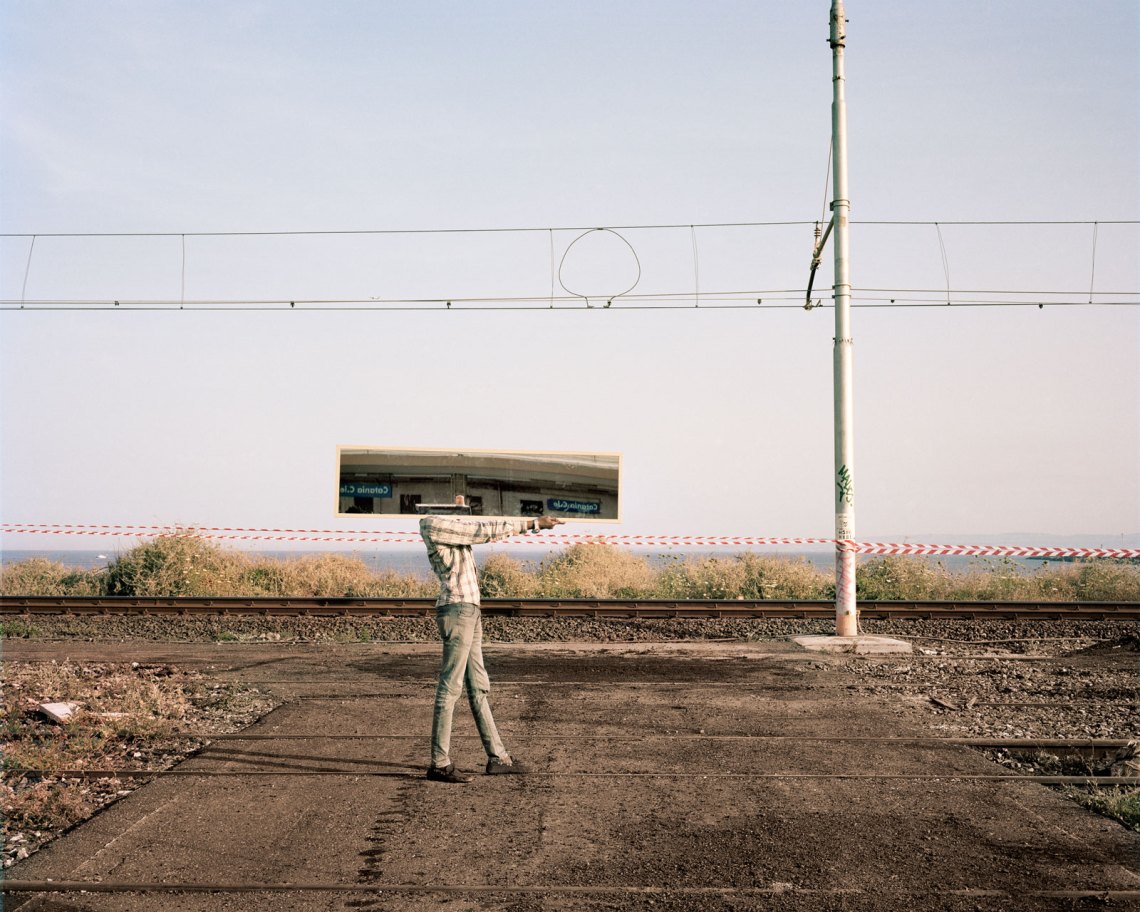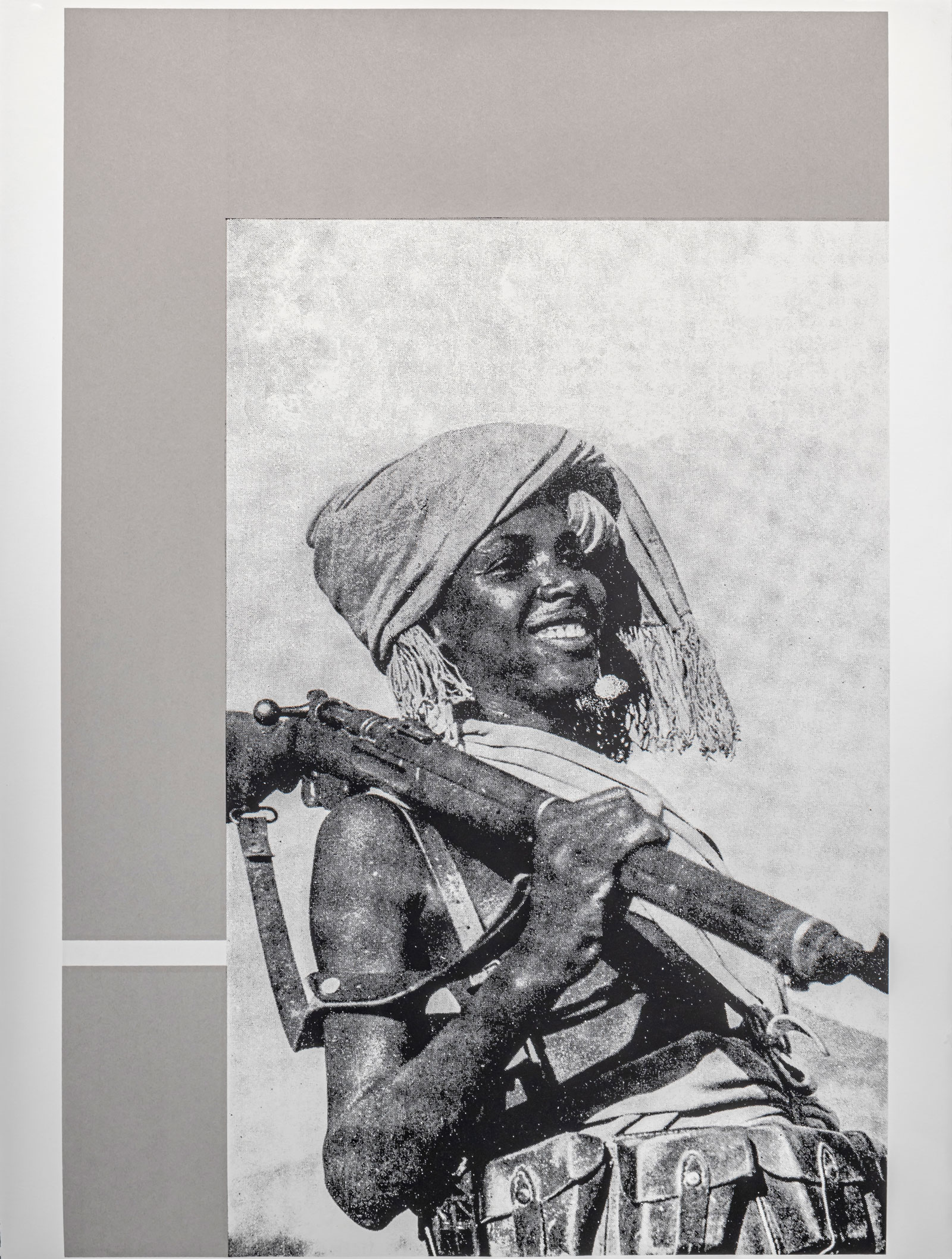The first photograph in the series of installation shots I received shows two rectangular plinths, placed a handbreadth apart. Each plinth, measuring forty-eight inches on the long side, bears a framed serigraph, a silk-screened image with three words: in the first, “La questione Italianna,” and in the second, “La questione Affricana.” This is the entryway to a multimedia exhibition of Dawit L. Petros, an Eritrean-born Canadian artist, guest-curated by Irene Campolmi at the Power Plant, a contemporary art gallery in Toronto (now temporarily closed to the public due to the pandemic). The title of the show, “Spazio Disponibile,” is an Italian phrase that translates as “Available Space”; it refers to the advertisement spaces offered by a government magazine to businesses during the heyday of Italian colonialism. Together, the exhibition title and the words on the serigraphs show an artist concerned with Italy’s historical relationship with Africa.
This focus on Eritrea’s former colonial power is clearer when considering the thirty-eight prints mounted on a long dividing wall, each of which is a page from the journal Rivista Coloniale, the widely circulated official mouthpiece of the Italian colonial government published between 1906 and 1943, informing Italians living in the colonies or abroad about the economy of their country. One series of monochrome pigment prints, titled “The constant re-telling of the future in the past” (2020), is a cluster of archival images—machines, farmhands, processions, a city center full of new cars, a Fiat factory—taken in Asmara, Eritrea’s capital city, sometime during the Italian occupation. These images of Asmara, taken between the mid-Twenties and the late Fifties, when it was described as piccola Roma, show Italians filling the city’s roads with Fiat cars, Italian bakeries, butchers, clothes shops, hairdressers, theaters, and cinemas. Indeed, a central preoccupation of Petros’s is how we choose to engage with the archive. He is interested in “metaphorical possibilities,” as he says in a video posted on the website of the gallery, in how histories are “either suppressed, are displaced, or are unexamined.” And specifically, in this exhibition, “the extent to which Italy has never confronted its colonial history.”
“It’s alarming how these histories of colonial encounter have been repressed within the Italian subconscious into an almost inaccessible space,” Petros said to Ethiopian-born novelist Maaza Mengiste in a conversation published in Recent Histories: Contemporary African Photography and Video Art (2016), edited by Joshua Chuang, Daniela Baumann, and Oluremi C. Onabanjo. “So when a stranger appears,” Petros continued, “the question of ‘From whence they came?’ arises. But we’ve been here. We’ve always been here! Part of the material I worked with—in which Italians perish in the Mediterranean, or Italians move to Libya—looks the other way. The contemporary departure point is the historical destination. Distance shrinks, and that refusal to remember becomes precarious.”
By the mid-Thirties, Italy’s colonial enterprise was known as the Empire of Oriental Africa, comprising the Horn of Africa, Libya, the Dodecanese Islands, and Albania. Most of these colonies were lost during or soon after World War II. Yet the effect on the imagination of the people of those former colonies remains today. In All at One Point (Casa, Study I) (2020), a two-channel video by Petros, the voice of a man in Asmara is juxtaposed with footage of Casa d’Italia, a community center built in Montreal by the Italian Consul General with funds from thirty-seven Italian organizations. Eritreans, including Petros’s family, began to enter Canada in significant numbers in the mid-Eighties. In 1936, the year the Montreal Casa d’Italia opened, several others were built around the world. Geometra Petros (no relation to the artist), the Eritrean man who narrates the video, is a surveyor and specialist in Italian colonial architecture. He speaks in Italian, with English subtitles: “When they went back to Italy, they totally forgot about us. They were homesick and thought of Eritrea. But they lost hope and totally abandoned the idea of Eritrea…. Italians had a close relationship with Eritrea because some of them were born here. Here, Italians lived in luxury; they had houses, industries, cinemas for their amusement…they lived well. It was their city, their little Rome.”
Later in the film, the artist’s namesake responds to a photograph of Casa d’Italia. It reminds him, he says, of the mosque of Asmara, built in 1938 on the initiative of Benito Mussolini. The mosque’s shutters are fascist symbols—an allusion to the “M” in Mussolini. The Italian leader had preferred architectural emphasis, not on minor aesthetic details, but on a modernist classicism that became the signature of Italian fascism. As the surveyor argues, both Montreal’s Casa d’Italia and Asmara’s old mosque are evidence of the reach of Italian fascism at the time.
Advertisement
“Spazio Disponibile,” for Petros, is a continuation of “The Stranger’s Notebook” (2014–present), his photo-based project that resulted from a thirteen-month exploration of migration within Africa and across the Mediterranean. During those journeys—whether in Tangier, Yamoussoukro, Lampedusa, Nouakchott, or Catania—Petros took photographs of men holding mirrors in front of their faces: a man standing on desert sand, a man overlooking the sea, a man on a beach, a man on a rock, a man in front of a train track. That they hold these reflective surfaces in place of their faces is symbolic of the experience of migrants, who are generally without legal identification and often perceived as the worst possible versions of themselves by their myopic hosts.
But Petros’s mirrors also challenge those hosts to appraise themselves. It is as though Petros is asking that they look at themselves while looking at those they designate as strangers. One photograph, Untitled (Overlapping and intertwined territories that fall from view II) (2019), shows the outstretched arm of Sammy—a young Eritrean in Catania, Sicily—as he faces the Mediterranean Sea holding a reproduction from Rivista Coloniale, two empty pages bearing the header “Spazio Disponibile.” Petros has paired it with Untitled (Overlapping and intertwined territories that fall from view I) (2019) to create a diptych; the second photograph shows the outstretched arm of another Eritrean man, Adil, who holds up a photograph of an Italian family with their backs to the camera, bearing suitcases. They are likely settlers from Sicily, and have arrived at Villaggio Olivetti, one of the agricultural villages built in Libya by Italy from 1927 onward and populated by poor farmers from southern Italy. Here are the hands of African men who are routinely decried as unwanted in Italy; they hold up evidence of a time, barely a century ago, when Italians (out of economic necessity, and as part of a colonizing project) were incentivized to take up residence in countries on the African side of the Mediterranean.
In another diptych, Untitled (Epilogue IV) (2019) and Untitled (Epilogue II) (2019), a man is pictured on the left standing on a tall, square concrete block, a range of hills undulating in the background; he holds a mirror at arm’s length, in front of his face. On the right, there is a close-up of the concrete blocks, totaling four, and a litter of stones. These photographs were taken in Nefasit, Eritrea, where those four concrete blocks formed a base for the Teleferica, once the world’s longest cable car—extending seventy-two kilometers to an elevation of 2,325 meters, when it connected the port town of Massawa to Asmara (it was dismantled in the Fifties when Italy lost its sovereign claim to Eritrea).
By juxtaposing the photographs taken in both Catania and Nefasit, Petros suggests a connection between the migration of East Africans to Italy and the legacy of colonialism. The logic of this connection shows how ahistorical it is for native Italians to consider the migration of Africans to Italy as an aberration—conveniently labeling them “illegal,” or denying entry to migrants or refugees arriving from the shores of Africa—since they, too, by imperial force and of necessity, had earlier made the reverse journey. Ethnonationalism here involves the deliberate attempt to repress the past.
*
That the camera is a subjugating tool is a familiar charge. What’s peculiar in the cases of Eritrea and Ethiopia is the relatively short period, compared to other African nations, of colonial rule—thanks largely to Italy’s defeats in World War II. The brevity of that dominion is one reason for the diminished colonial memory of many Italians today, ignorant of the fact that that their forebears built little Romes in the Horn of Africa.
Maaza Mengiste’s two novels have taken her country’s official history to task, whether in relation to the revolution that led to the ouster of Emperor Haile Selassie or in its account of the Second Italo-Ethiopian War. In her second novel, The Shadow King (2019), shortlisted for the Man Booker Prize, the story is an epic retelling of the war fought during Mussolini’s 1935 invasion of Ethiopia, a story of the heroism of Ethiopian women who took up arms alongside their husbands or masters, of the villainy of the men on both sides, and of a weapon as formidable as any other—the camera, an apparatus used to make images that could sustain Italian propaganda and keep the soldiers titillated on the battlefield.
Advertisement
At the beginning of Mengiste’s novel, the protagonist, a woman named Hirut, holds a metal box that includes letters, newspaper clippings, and photographs. Hirut had been a soldier when, forty years earlier, she had been captured as a prisoner of war. A photograph that had been taken of her then is among these records from the past, “the many dead that insist on resurrection,” Mengiste writes. Hirut is on her way to meet the Italian soldier who took the photograph. It had been his job to take pictures of Ethiopians at their moment of capture or soon afterward, including those he photographed just before they were shoved from a cliff.
The last section of The Shadow King is titled “Photo,” and it is one of nearly a dozen standalone sections in the novel in which photographs are described with narrative vignettes. They are not meant to stay faithful to visual or historical detail as much as they are intended to evoke and restore the uncompromised humanity of those subjected to the denigrating view of the camera. It is a counter-archive wrested from images; a photo album as testament to the Ethiopian will to untether itself from the Italian gaze with words.
In a remarkable indication of the intellectual affinity between Mengiste and Petros, in one of the photographic prints from Rivista Coloniale displayed in “Spazio Disponibile,” a woman holds a rifle. The image fits Mengiste’s description of Hirut’s Wujigra: “A bolt-action, 11mm rifle designed to deliver a single lethal shot with consistent accuracy, a hardy gun able to withstand cold and rain, repeated and rapid firing.” The woman wears a turban, with the rifle held above her right shoulder angled toward the top of the frame. Her arms are slender but firm, and her fingers encircle the rifle’s midpoint; she’s wearing a bullet pouch around her waist. She smiles broadly, an unexpected, even precious detail; it is unclear if she is a rebel fighter, or an ascari, one of the soldiers from Eritrea, Somalia, or Ethiopia itself serving on the Italian side. Mengiste writes in The Shadow King of photographs of women soldiers:
They are made into postcards and passed out to [the Italian colonel’s] men. They are sent to newspapers and used by journalists. They are kept as souvenirs and discussed in administrative meetings. The photographs of the women are distributed to shops in Asmara and Addis Ababa, in Rome and Calabria, in officers’ clubs in Tripoli and Cairo. [They] are called many things: Angry Woman, Woman Warrior, African Guiliette. They are handled and ripped and framed and pasted into albums and from everywhere come the requests: Can we put them in front of huts with their rifles?
The text of the original “La questione Italianna” was published on a page measuring twelve by nine inches in a brochure written by an Italian government official in 1888, two years before Eritrea was formally declared an Italian colony. Petros has not only silk-screened the image and enlarged it to forty-five by sixty-three inches but has also designed the accompanying “La questione Affricana.” The pages from Rivista Coloniale were originally printed as six by eight inches; Petros has enlarged them into twenty-two-by-thirty-inch prints. Petros’s manipulation of these images suggests the ways that the originals were fictions to begin with, their meanings subject to reinterpretation. “Spazio Disponibile” was designed so that visitors could exit the gallery between those silk-screened images, just as they had come in. La questione Italianna; la questione Affricana. History is an evolving proposition.
Dawit L. Petros’s “Spazio Disponibile” was on view at The Power Plant, Toronto. Maaza Mengiste’s The Shadow King is published by W.W. Norton Company.


